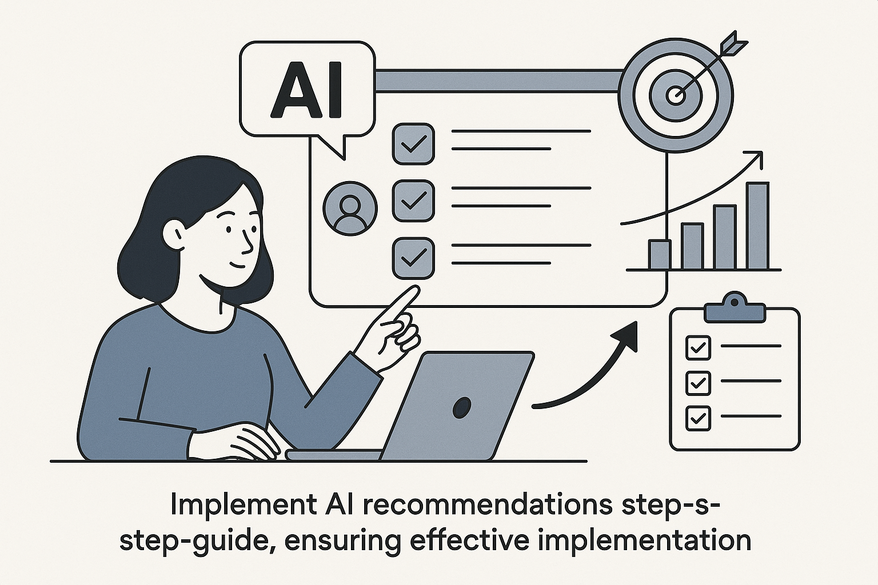How to Turn AI Recommendations into Action: A Step-by-Step Guide
Learn to turn AI recommendations into action with our step-by-step guide, ensuring effective implementation for measurable results and organizational impact.

Estimated reading time: 8 minutes
Key Takeaways
- Bridge insights to action: Follow a structured process from understanding AI outputs to executing strategic pilots.
- Prepare thoroughly: Assess infrastructure, align stakeholders, and set SMART objectives before implementation.
- Analyze & prioritize: Translate AI outputs into business language, involve domain experts, and use frameworks like ICE scoring.
- Build a clear plan: Define pilot scope, develop a roadmap, and integrate AI technically with RACI accountability.
- Use best-in-class tools: Leverage platforms like Tealium AudienceStream CDP and Tribe.ai, and follow governance and iteration practices.
Table of Contents
- Section 1: Understanding AI Recommendations
- Section 2: Preparing for Implementation
- 2.1 Assess Current Infrastructure
- 2.2 Identify Stakeholders & Build Cross-Functional Teams
- 2.3 Set Clear Objectives & KPIs
- Section 3: Analyzing & Interpreting AI Recommendations
- Section 4: Creating a Strategic Action Plan
- Section 5: Practical Tools & Best Practices
- Conclusion & Next Steps
- Additional Considerations
- Future Trends
Section 1: Understanding AI Recommendations
Keywords: turning ai recommendations into action, AI recommendations
AI recommendations come in many forms. Knowing when and where they emerge helps you move from data to decisions. Tealium’s guide defines this process as converting insights into real-world change. Effective implementation drives competitive advantage, efficiency, and innovation. StartUs Insights notes that success links data science to clear targets, while Harvard Business School Online emphasizes aligning AI strategy with business goals.
Typical Forms by Industry
- Retail: personalized product suggestions, dynamic pricing.
- Manufacturing: predictive maintenance alerts from sensor data.
- Finance: risk assessment flags for high-risk transactions.
Common Sources of AI Insights
- Machine learning models trained on historical data.
- Predictive analytics tools that identify trends.
- AI platforms analyzing customer behavior or operational metrics.
Successful Case Studies
- Retailer A increased average order value by 12% with targeted product suggestions.
- Logistics firm B cut route costs by 18% using AI-driven routing.
These examples show how AI recommendations become real gains through action. Tribe.ai applied AI outlines similar success stories.
Section 2: Preparing for Implementation
Keywords: turning ai recommendations into action
Preparation ensures your AI pilots run smoothly. Focus on three key areas before acting on insights.
2.1 Assess Current Infrastructure
Use an “AI-first scorecard” to evaluate readiness:
| Readiness Area | Level 1: Basic | Level 2: Intermediate | Level 3: Advanced |
|---|---|---|---|
| Data Ingestion | manual uploads | automated ETL | real-time streams |
| Model Deployment | batch-only | scheduled jobs | API-driven |
| Monitoring & Alerts | none | basic dashboards | automated alerts |
Score each area, identify gaps, and plan needed upgrades. Guidance: Harvard Business School Online.
2.2 Identify Stakeholders & Build Cross-Functional Teams
- CIO/CTO for technical vision
- Data scientists for modeling expertise
- IT engineers for integration
- Business leads for domain insight
- End users for feedback loops
Hold a kickoff workshop, set a regular update cadence, and clarify roles to keep projects on track. See StartUs Insights and Tribe.ai applied AI.
2.3 Set Clear Objectives & KPIs
Define SMART goals:
- Specific: reduce customer churn by 15%
- Measurable: track churn rate monthly
- Achievable: align with historical trends
- Relevant: link to revenue growth
- Time-bound: within six months
Example KPIs include ROI on AI projects, staff adoption rate, and forecast accuracy improvement. Reference: Tealium’s guide and Harvard Business School Online.
Section 3: Analyzing & Interpreting AI Recommendations
Keywords: turning ai recommendations into action
After generating insights, translate and prioritize to convert AI outputs into decisions.
Technique 1: Translate Outputs into Business Language
- Provide plain-language summaries.
- Present clear charts and visuals with labeled axes.
- Include concise captions and legends.
Technique 2: Involve Domain Experts
- Product managers review customer insights.
- Maintenance leads vet sensor alerts.
- Validate AI findings against real-world scenarios.
Prioritization Framework
| Recommendation | Impact (1–5) | Confidence (1–5) | Ease (1–5) | ICE Score |
|---|---|---|---|---|
| Personalize emails | 4 | 5 | 4 | 13 |
| Predictive routing | 5 | 4 | 3 | 12 |
Sort by ICE score and focus on the highest values first.
Common Pitfalls & Mitigations
- Data bias: run fairness checks with diverse samples.
- Overfitting: apply cross-validation and holdout sets.
- Correlation vs. causation: conduct A/B trials before full rollout.
These steps help you move insights to action safely and smartly. References: Tealium’s guide, Tribe.ai applied AI, StartUs Insights.
Section 4: Creating a Strategic Action Plan
Keywords: turning ai recommendations into action
A structured plan ensures recommendations become operational workflows.
Step 1: Define Pilot Scope
Choose use cases with highest business impact, minimal technical risk, and measurable outcomes. Document expected results and metrics.
Step 2: Develop Project Roadmap
Outline key milestones:
- Data integration readiness
- Model deployment to test environment
- User testing completion
- Go-live date
Assign roles with a RACI chart: Responsible, Accountable, Consulted, Informed.
Step 3: Technical Integration
- Map AI outputs to system inputs (APIs, CRM events).
- Embed AI triggers into standard process workflows.
Step 4: Testing & Validation
- Run A/B tests comparing AI-driven vs. control scenarios.
- Monitor lift metrics such as conversion rates.
- Adjust model parameters based on results.
Step 5: Scaling Up
- Enhance infrastructure to handle increased load.
- Automate model retraining on a schedule.
- Set performance-drop alerts.
Change Management Plan
- Secure executive sponsorship.
- Distribute communication checklists.
- Provide training on revised AI workflows.
This action plan transforms AI recommendations into repeatable processes. Learn more at StartUs Insights, Tribe.ai applied AI, and Harvard Business School Online.
Section 5: Practical Tools & Best Practices
Keywords: turning ai recommendations into action
Equip your team with the right platforms and governance to sustain AI-driven action.
Tools Overview
- Tealium AudienceStream CDP for data unification and action rules.
- Tribe.ai applied AI platform for end-to-end project support.
- Cloud ML services such as AWS SageMaker, Azure ML, and Google AI Platform.
- BI dashboards including Tableau and Power BI.
Beauty-tech innovators like Makeup Check AI blog demonstrate how AI insights lead to personalized user actions. Explore Virtual Makeup Try-On innovations and see an AI makeup coach in action.
Best Practices
- Data Governance: build a data catalog, control access, and track lineage.
- Continuous Improvement: establish feedback loops, retrain models, and monitor performance dashboards.
- Transparency: publish KPI dashboards and set alerts for data drift or errors.
Real-World Example
A logistics firm used predictive routing to cut costs by 12%, combining sensor data and ML tools to act on AI insights in real time. This clear link from insight to action drove substantial savings.
For beauty teams implementing AI recommendations directly in user-facing solutions, Makeup Check AI is an AI Makeup Generator translating model outputs into actionable suggestions in real time.
Conclusion & Next Steps
Keywords: turning ai recommendations into action
You now have a clear framework to:
- Understand AI recommendations
- Prepare your team and infrastructure
- Analyze and prioritize insights
- Create and execute a strategic plan
- Leverage tools and best practices
- Monitor, refine, and scale
Call to Action
Launch a pilot within 30 days. Use our action-plan template to guide your first project and iterate based on results.
Additional Considerations
Ethics & Compliance
- Conduct Data Privacy Impact Assessments.
- Ensure GDPR and CCPA compliance.
- Perform bias audits with human-in-the-loop reviews.
- Establish clear data consent policies.
Further reading: StartUs Insights, Tribe.ai applied AI.
Future Trends
- Event-driven architectures for real-time recommendation delivery.
- Automated MLOps pipelines enabling continuous deployment.
- Emerging regulations and evolving AI governance best practices.
Explore more at Tribe.ai applied AI and StartUs Insights.
FAQ
- Q: What is the first step in turning AI recommendations into action?
A: Begin by assessing your current data and technology readiness using an AI-first scorecard to identify gaps. - Q: How do I prioritize multiple AI recommendations?
A: Use a framework like ICE scoring (Impact, Confidence, Ease) and focus on high-value, low-complexity actions first. - Q: Which tools help operationalize AI recommendations?
A: Platforms such as Tealium AudienceStream CDP for data activation and Tribe.ai for end-to-end AI implementation are key options. - Q: How do I ensure compliance and ethics?
A: Implement data privacy assessments, bias audits, and human-in-the-loop reviews, and follow GDPR/CCPA guidelines. - Q: What’s crucial for scaling AI-driven workflows?
A: Automate infrastructure scaling, schedule model retraining, and set performance alerts for continuous monitoring.




